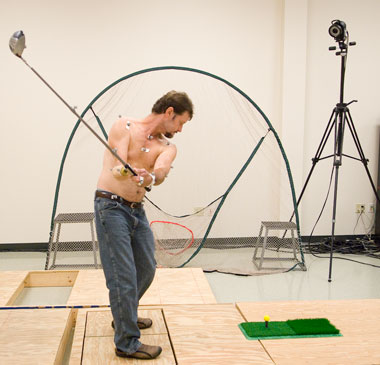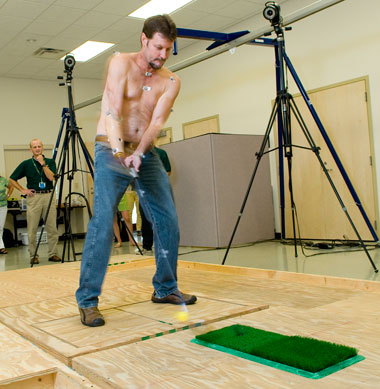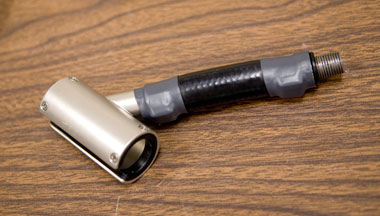Amputee helps USF test new 'hand'
As Alan Hines swings his golf club, his every movement is being recorded, digitized and collected by specialized equipment in the USF Motion Analysis Laboratory.
Hines, who lost his right hand in an electrical accident 11 years ago, is helping researchers from USF’s School of Physical Therapy and Rehabilitation Sciences and the College of Engineering collect data about his movements while he wears a new prosthesis designed specifically for swinging a golf club. Data from the project will be incorporated into a larger study funded by the Department of Defense that is looking at upper extremity prosthetic component and training options for amputees.
“We’ve cataloged movement data from other tasks before for this project, including turning a steering wheel, drinking from a cup, and kayaking, but now we can add information about swinging a golf club, an activity that many amputees might like to do,” said Jason Highsmith, PT, DPT, assistant professor in the School of Physical Therapy and Rehabilitation Sciences.

Dr. Jason Highsmith attaches a “hand” that will allow Alan Hines to hold and swing a golf club.
This session in the Motion Analysis Laboratory is Hines’ third and final for trying a device made of high performance synthetic rubber that attaches to his prosthetic arm at one end and slips over the golf club handle at the other end. The rubber flexes and absorbs the energy of the club’s impact with the ball, closely mimicking a living wrist and fingers.


As cameras track his every move, Alan Hines swings and hits a golf ball in the USF Motion Analysis Laboratory.
The device was developed by Bob Radocy, an amputee and engineer based in Boulder, CO, who donated prosthetic components helping to make the study possible.



Some of the “hands” that were studied.
Hines has reflective markers attached at various points and joints on his body, allowing the eight high-frequency digital cameras (the same used to make the films Polar Express and Avatar) to follow his movements. He stands on force plates on the floor so that his weight shifting and ground reaction forces could be measured, as well.
The information collected by specialized computer software provides researchers with high-resolution, 3-D optical tracking that analyzes body motion, from the smallest movements needed to breathe to the broadest motions needed to pitch a baseball more than 90 miles an hour. Or in this case, to swing a golf club.
“We’re looking for the best way to make these movements biomechanically,” said Stephanie Carey, PhD, a researcher for the USF Center for Assistive, Rehabilitative and Robotics Technologies (CARRT) in the College of Engineering.
“In addition to looking at design, fit and training, we are also tracking elbow position, club speed, preferred grip, and angles of motion.”


Dr. Stephanie Carey uses specialized software to compile data collected by eight cameras that track the movement of the markers on Alan Hines.
Hines said he saw the project as a way to help other amputees.
“When I was asked if I’d like to be a part of this project, I didn’t hesitate to help out,” Hines said.
But Hines said he also saw it as a way for him to spend more time with his 14-year-old son Shane, who plays golf, and was enjoying the prospect of joining him on the golf course.
The study included a session at the Eagles Golf Club in Odessa. At left, Dr. Jason Highsmith (left) helps attach the device to Alan Hines (right) with golf coach Tom Shea (center). At right, Hines takes a swing.
Story by Sarah A. Worth, photos by Eric Younghans, USF Health Office of Communications.



